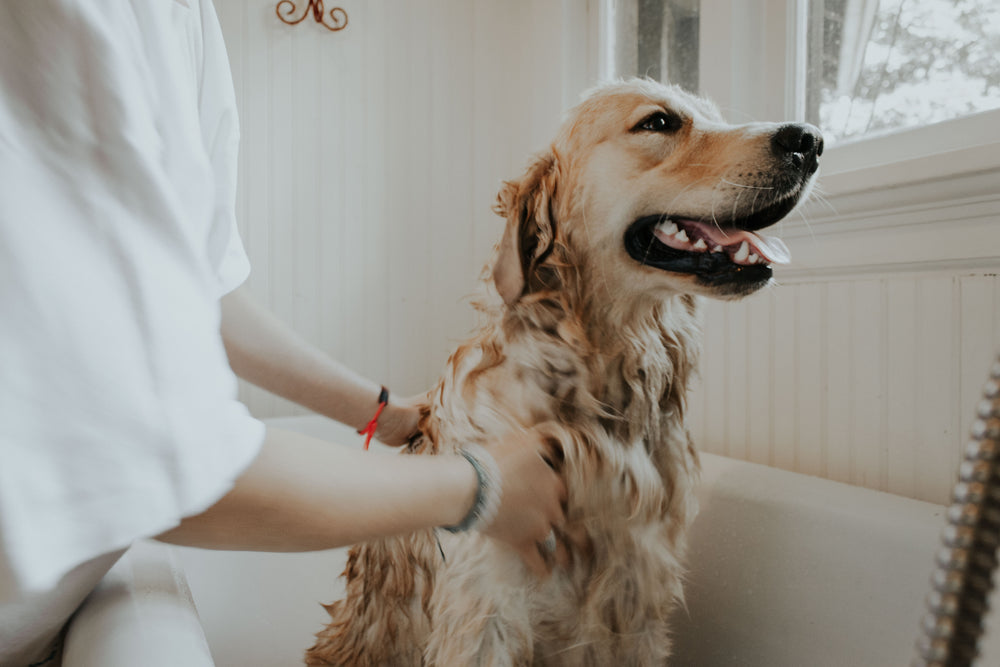
A pet is the physical embodiment of unconditional love – no matter what, they’re always there to comfort you, or joyfully greet you as you come home from your 9 to 5 (or, in dog years, a million years, where were you buddy?) – They bring us happiness, so naturally we want to pamper them. We want them to always have the best of the best, because we love them. That doesn’t just extend to the food they eat or where they sleep, but also what they bathe in. So many dog shampoos are marketed as all natural and dog safe…but are they?
Here a list of some chemicals to look out for when buying shampoo for your canine companion.
1. Formaldehydes and Sulfate Benzoate
“Formaldehydes? Excuse me?” you might be saying. Yes! They may have been phased out of human shampoos (or so we're told,) but they're kicking around in pet shampoos and products in disguise! They could be lurking in your dog’s shampoo under names like:
Bromopol
Doazolidinyl urea
DMDN Hydantoin
Imidazolidinyl urea
Quaternium-7, -15, -31 -61
Sodium hydroxymethylglycinate
And even under such vague labels as “Preservatives”
These are formaldehyde derivatives that release small amounts of the chemical over time and can cause health concerns such as skin irritation and rashes, and its also known to be a carcinogen. Look near the end of the ingredient list, as that’s where they’re most likely to be listed.
Sodium Benzoate is a bit of a trickier compound; it’s not toxic on its own, but when mixed with citric or ascorbic acids (Vitamin C), it can become benzene – a carcinogenic chemical that causes blood disorders and leukemia.
2. Sulfates
Luckily, there’s been a lot of attention on sulfates and their less-than-positive effects, and many shampoos and products for humans and pets are now sulfate free.
Sulfates are sulfur-based chemicals derived from petroleum and laurel alcohols, themselves extracted from coconuts and other plants. They may be marketed on labels as “coconut based cleaners.”
Sulfates are surfactants, which essentially means they strip oil and grease from hair and skin. Sounds good right? No more dirt and mess!
They don’t discriminate, however; they’ll lift whatever oily mess Fido rolled around in, but they’ll also lift and strip the natural oils in his hair and skin that afford him a measure of protection against irritation. A sulfate shampoo can cause rashes, itchiness and dryness.
It doesn’t sound very serious compared to a carcinogenic compound, but the buck doesn’t stop there for sulfates. In the process of turning the petroleum and laurel alcohols into sulfates like sodium lauryl sulfate (SLS) and sodium laureth sulfate (SLES), by-products are created in the form of carcinogenic contaminants like 1,4-dioxane, sodium laureth sulfate and ammonium laureth sulfate. The EPA has listed 1,4 dioxane as a likely human cancer-causing agent and it’s also suspected to cause birth defects, nasal and liver tumors, and affect the nervous system and kidneys. Here are some of the names to look for:
Sodium Lauryl Sulfate
Sodium Laureth Sulfate
Ammonium Lauryl Sulfate
Ammonium Laureth Sulfate
Sodium Coco Sulfate
TEA Lauryl Sulfate
MEA Lauryl Sulfate
If you’re currently using a shampoo with SLS or SLES, watch out for Rover’s eyes! They can cause cataracts, which is just the icing on the dangerous chemical cake, isn’t it.
3. Ethanolamines
Last but not least, Ethanolamines. Ethano-whats? They join the ranks of the other tongue-twister chemicals on this list as "dangerous when playing with others." Ethanolamines are a group of chemicals made of proteins and alcohols that smell of ammonia. There are three that fall under the Ethano-umbrella:
MEA- Monoethanolamine
DEA- Diethanolamine
TEA- Triethanolamine
Ethanolamines are used by manufacturers for their creamy texture and good foam; they also lower the surface tensions of substances, which allows water soluble and oil soluble compounds to cohesively combine. However, when ethanolamines are used in the same product as preservatives, they break down into nitrogen and can form what is called nitrosamines. Nitrosamines are chemicals that are thought to be carcinogenic, and have toxic effect on organs and reproductive systems.
Unfortunately for some of the things on this list like sulfate contaminants, manufacturers are not required to list them on the ingredients, and the amount in any product would depend on the processing protocols for each manufacturer, let alone if the processes include the removal of the contaminants to begin with. Sadly, there are no studies that have analyzed the quantities of any contaminants in dog shampoo, so to be as safe as possible, it’s best to avoid them. Pay close attention to what’s on the label the next time you’re in the market for shampoo!
DERMagic’s quality products do not contain any of these chemicals.
Thanks to:
Dogs Naturally Magazine
Photo by Autri Taheri on Unsplash

